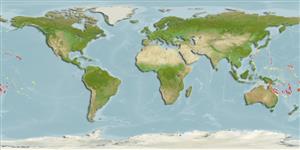Teleostei (teleosts) >
Blenniiformes (Blennies) >
Tripterygiidae (Triplefin blennies) > Tripterygiinae
Eponymy: Dr Victor Gruschka Springer (d: 1928) is an American ichthyologist. [...] Dr Michel Kulbicki is a Research Director who was working at IRD Noumea, New Caledonia (2016). He collected the holotypes of both species. He and senior author Fricke co-authored: Checklist of the shore fishes of New Caledonia (2007). (Ref. 128868), visit book page.
More on authors: Fricke & Randall.
Environment: milieu / climate zone / depth range / distribution range
Ecology
Marine; reef-associated; depth range 2 - 15 m (Ref. 13227). Tropical
Southwest Pacific: Australia to New Caledonia, Fiji, then east to Tonga, Niue and American Samoa.
Size / Weight / Age
Maturity: Lm ? range ? - ? cm
Max length : 3.5 cm SL male/unsexed; (Ref. 54980)
Short description
Identification keys | Morphology | Morphometrics
Dorsal spines (total): 14 - 18; Dorsal soft rays (total): 6 - 10; Anal spines: 2; Anal soft rays: 18 - 21. Dorsal profile steep with very short snout; head and preopercular area naked; slender supraorbital tentacle; first dorsal fin a third of the height of second dorsal fin; body coloration gray with 5 indistinct, broad, paired brown bars; uneven bright orange spots on head and anterior body, small posteriorly, and mostly orange on posterior margins of scales; caudal-fin with black base, gray center with a midlateral orange band, a thin white margin, black submarginal line, and a wide bright red-orange arc. Dorsal rays III + XI-XV + 6-10; lateral line discontinuous, 21-22 + 17-19; mandibular pores 3 + 2 + 3 (Ref. 54980).
Eggs are hemispherical and covered with numerous sticky threads that anchor them in the algae on the nesting sites (Ref. 240). Larvae are planktonic which occur primarily in shallow, nearshore waters (Ref. 94114). Minimum depth from Ref. 58018.
Life cycle and mating behavior
Maturity | Reproduction | Spawning | Eggs | Fecundity | Larvae
Fricke, R., 1994. Tripterygiid fishes of Australia, New Zealand and the southwest Pacific Ocean (Teleostei). Theses Zool. 24:1-585. (Ref. 13227)
IUCN Red List Status (Ref. 130435: Version 2024-1)
Threat to humans
Harmless
Human uses
Fisheries: of no interest
Tools
Special reports
Download XML
Internet sources
Estimates based on models
Preferred temperature (Ref.
123201): 24.9 - 29.4, mean 27.6 °C (based on 700 cells).
Phylogenetic diversity index (Ref.
82804): PD
50 = 0.7500 [Uniqueness, from 0.5 = low to 2.0 = high].
Bayesian length-weight: a=0.00617 (0.00288 - 0.01322), b=3.04 (2.86 - 3.22), in cm total length, based on LWR estimates for this (Sub)family-body shape (Ref.
93245).
Trophic level (Ref.
69278): 3.1 ±0.3 se; based on size and trophs of closest relatives
Resilience (Ref.
120179): High, minimum population doubling time less than 15 months (Preliminary K or Fecundity.).
Fishing Vulnerability (Ref.
59153): Low vulnerability (10 of 100).
Nutrients (Ref.
124155): Calcium = 479 [180, 1,873] mg/100g; Iron = 2.37 [0.84, 5.41] mg/100g; Protein = 18.2 [16.4, 19.9] %; Omega3 = 0.0987 [, ] g/100g; Selenium = 60.9 [11.7, 256.0] μg/100g; VitaminA = 44.9 [6.3, 314.5] μg/100g; Zinc = 5.64 [2.49, 10.53] mg/100g (wet weight);
